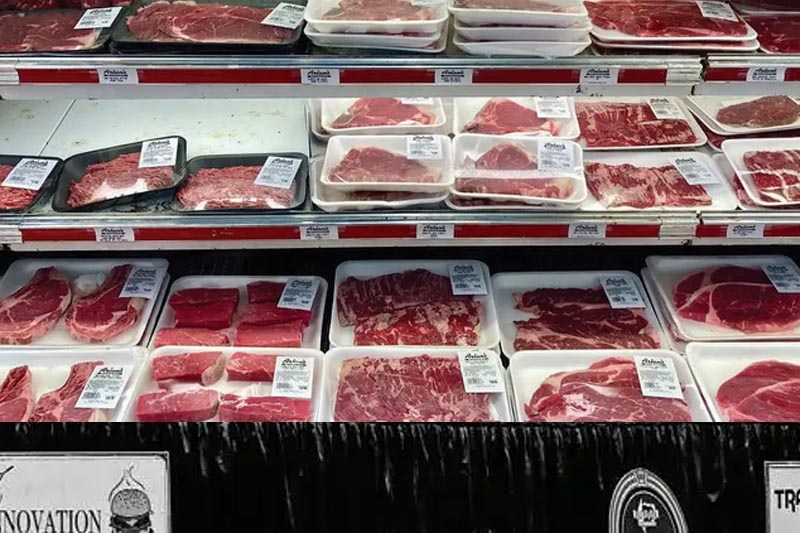by Lilly Platts
What does the consumer want, and how can the industry respond to demand?
Consumer demand, purchasing habits, and under standing the factors that go into a person’s decision to purchase (or not purchase) beef is the ultimate consideration at the end of the beef production system. Knowing what the consumer wants, and following trends, can help inform many decisions throughout the beef system.
Bryon Wiegand is currently professor of Animal Science at the University of Missouri. He has a broad range of teaching and research experience in meat sciences, and shared about consumer demand during the 2024 Fall Focus Educational Symposium.
Wiegand opened by saying, “I think today you’ll find that beef producers have some things to be very happy about. We’re very competitive in this space, in terms of protein. I think we also have some challenges, and we should not get complacent as beef producers.”
The US consumes a significant amount of beef, and as Weigand explained, situations like the COVID-19 pandemic demonstrate that when people are faced with feeding themselves during times of unrest, they are going to reach for animal proteins. Chicken is the most consumed protein in the US, followed by beef.
Wiegand discussed alternative proteins, which were making headway in the market until recently. “Quite frankly, the alternative protein market is getting crushed in the economy right now,” he said.
Beef stands apart from other proteins because of the focus on consistency, and measurable quality. Looking at the history of beef demand, Wiegand pointed to the period through the late 1990s when consumers demanded that beef be more tender. The industry responded, and today most beef, across quality grades, is tender when cooked correctly.
When evaluating the factors that consumers care about the most, Wiegand shared that data shows price, freshness, and taste as top priorities for many.
Quality grades have also improved steadily over the last 20 years. According to the USDA, in 2000, 3.3% of beef cattle graded prime; in 2010 that number had climbed to 10.5%. As cattle continue to be fatter at finish and genetics improve, this trend is expected to continue.
When evaluating the factors that consumers care about the most, Wiegand shared that data shows price, freshness, and taste as top priorities for many. One of the more difficult priorities to evaluate is how social values affect consumer behavior. Wiegand explained that animal welfare is an increasingly important issue for consumers, especially as social media makes it easier for information — true or false — to be shared. However, data shows that social media and other factors might actually be overemphasizing the importance to consumers, compared to other factors like cost. “At the end of the day, consumers care about what it costs, what it tastes like, and they don’t seem to be upset about how we’re making it,” he said. “A big portion of consumers have a positive perception of beef as a food item.”
Consumers were asked to rank their top three factors when purchasing beef, and bottom three. Image courtesy of Kansas State University.
Beef prices are currently high, which is a concern for both producers and consumers. Wiegand posed the question of how long consumers will be willing to continue to buy beef if the price continues to go up. So far, consumers have continued purchasing beef. “The consumer has stayed with us, and we should feel good about that,” Wiegland said, sharing data comparing price with the amount of beef purchased from September of 2019 to June of 2022.

E-commerce and direct-to-consumer marketing has changed consumer behavior. Wiegand represents small processors in Missouri, and has had conversations with many producers who are interested in building their finished beef business. For some time, these businesses were challenged by having high demand for premium cuts, like steaks, and lower demand for middle cuts, which are generally ground into hamburger. Wiegand explained that because of lower supply and stronger demand, that has been less of an issue. When grocery prices are high, consumers are more likely to reach for lower-priced products.
Wiegand also discussed how cow inventory affects the industry’s ability to meet consumer demand. Historically, when demand and price are strong, any gaps in the market are filled with fat open cows and cull bulls. The current cow inventory is low, but market weights are up, and consumer demand continues to be met. “We are, for the most part, meeting the demand of our consumer,” he said.
Beef producers are constantly faced with volatility, from the weather to feed prices, which Wiegland also discussed. Land price and availability is another major factor — farming, development, and conservation programs often entice landowners to move away from grazing, which ultimately makes it more difficult for new producers, and for existing producers who want to expand their herd. New farming technology has made it easier, and more profitable, for land to be tilled. “If we’re in the business today, we’re probably not going to see a huge cow herd rebuild. That’s good for those of us who are still in the game, because we’ll see consumer demand hang in there with us,” he said.
The economy as a whole affects producers and consumers. Currently, interest rates are high, cash deposits are down, and credit card debt is up. Wiegand shared that this environment, and the general tightening of budgets, hasn’t affected beef consumption notably, but that the industry is going to have to wait and see how it ultimately shakes out. “We should feel good about where we’re at. We should also be a little cautious about the consumer’s ability to stay with us. I think we’re going to feel a bit of a squeeze, but you should feel good about what you’re producing,” Wiegland concluded. .








